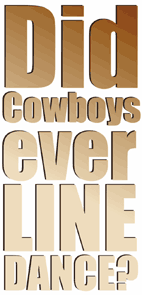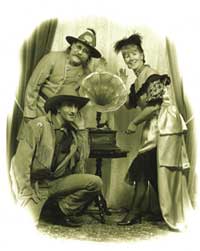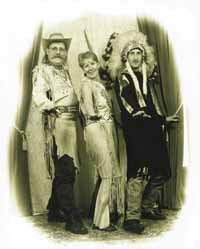| HOME | LINEDANCE | TRAIL DANCER | ARCHERY | More about GUTZ | E-MAIL TO GUTZ |
 LINEDANCE HISTORY
|
|||||||||||||||||||||||||||||
|
Think of the Wild West and the imagination runs away with itself. Myth, mystery and a healthy supply of romantic fiction conjure up a satisfying picture of gun toting Clint Eastwoods, head hunting Apaches, and stressed out sheriffs trying to enforce the rule of law. The very fact that the genre of spaghetti westerns was inspired by an Italian should set alarm bells ringing. It’s understandable that line dancers would like to see their own history within the same frontier fairy tale but the reality, if a little boring, is somewhat different. As Cathy Hellier, dance historian at the Williamsberg Research Foundation in Virginia points out, rather puzzled by our phone call, “line dance is a modern form of dancing, isn’t it?”
Conditions on the western frontier in the 18th and 19th centuries were severe. True, the early settlers were predominantly men but line dance didn’t evolve just because they weren’t too keen on dancing cheek to cheek. Survival was the main priority, and any “free” time would most likely have been spent lying very still with their eyes closed. It’s not possible to plot line dance on a continuous graph. But what the settlers did bring with them were their own national traditions of dancing that form the basis of what we all enjoy today. The original Schottische arrived from Poland. German settlers introduced “clogging”, while Cajun influences not surprisingly can be laid squarely at the doorstep of the French. None of these guys did the Tush Push, Cajun Mambo Walk or Roll Back The Rug. In the first place, they wouldn’t have known what a “tush” was. You have to take a leap into this century to discover the first sightings of line dance, which in its recognisable form swung in on the coat tails of rock and roll. There emerged what can be described as “fad” dances like the Stroll and later the Madison, and as disco music took hold in the 70s the Hustle craze started followed by a distinct line dance called the Bus Stop, which closely resembled the Electric Slide. The film industry was an important boost, classically Grease (remember the Hand Jive?) and the movie Urban Cowboy in the early 80s, which sparked a trend in country clubs doing Cotton Eyed Joe, Two Step, Waltz, Swing and about three or four line dances. If you had taken the floor back then, most likely you would have found yourself learning the Tush Push, Four Corners, the Stomp, and something very like Elvira or Texas Freeze. Originally line dances were choreographed to all kinds of music. The Tush Push, written by Jim Ferrazzano in 1980, was first intended for big band music at a speed of 140 bpm! A lot of dances were done as folk dances or party mixers that were adapted to country music and given “cutesy” country titles by ex-ballroom teachers. The Cowboy Charleston was by no means a country dance, and neither was the Alley Cat. The Barn Dance Mixer (Wild, Wild, West) was a Merengue or Paso Doble party mixer . Line dance climbed into bed with country music when Billy Ray Cyrus wrote Achy Breaky Heart in 1992. A clever marketing trick, Melanie Greenwood’s dance was written to promote the song. Five years later and Achy Breaky Heart has snowballed into the biggest dance craze ever, line dancing choreographed to country music. Not the legacy of bold frontier settlers with the American Dream in their hearts, but an ingenious ploy to sell records. Bang goes the fairy tale. Enjoyable, straightforward to learn and not requiring a partner, line dance was bound to spread. In many countries, particularly across continental Europe, the US military laid the first foundations, sharing line and country dance with the locals. A long standing affection for country music in the UK was a powerful springboard, and line dance rapidly became a part of the holiday camp country music scene. And so we’ve gone an international full circle, with different nations of dancers now adding their own ideas and interpretations, just like they’ve always done. That’s the best way to see line dance and its history, as a family of dance styles, pieced together from a jigsaw puzzle of nations. The spaghetti western theory may make a better story line but that’s Hollywood for you. You don’t have to believe us if you don’t want to.
|
|||||||||||||||||||||||||||||
| A
VERY INTERESTING ARTICLE ABOUT POP VERSUS COUNTRY MUSIC AND
WHERE LINEDANCING IS COMING FROM! PUBLISHED BY MIKE TYLOR IN THE LINEDANCER MAGAZINE MESSAGE BOARD: Mike Tylor -
taylormademusic@yahoo.com It is NOT aimed at criticising any particular group of people or organisation. I cannot and will not apologise if anyone gets upset whilst reading whats below. I cannot distort history...but I know a COUNTRY that can. For many, many years we
Brit's and the rest of the World have been subjected to the
American version of World history via their movies. What a lot of
people do not realise is that once history has been changed on
celluloid, it is only a matter of time before people (especially
the Americans themselves) think it's TRUE. There are too many
examples to mention...could be that in a few years time a film
will appear where it is the American's who invented the WHEEL and
only because they needed something to move along (no pun intended)
their other great invention, the AUTOMOBILE. Remember the saying
about ' You can fool most of the people........' Over a period of time there have been lots of comments (via letters and email) relating to the 'COUNTRY vs POP' saga...and to be quite honest its boring. Boring because nobody has researched then wrote...its all been based on a emotive basis. Even the most recent letters within Linedancer Magazine by Karen Smith (January), Brandi Brown,Graham & Barbara Smith and G. Roberts (all March) as good and as valid as their comments are they seemed to be missing the crux of the matter. Its time to lay down a few (well researched and documented) FACTS. For people who live and breathe, think and dream only 'American' Country Music- NOW would be a good time to go to another 'thread'..because this could hurt....worst still it may stop you long enough to think. ..the rest of you - make yourself a drink, settle down, relax..and read on.. The term 'Country' as in country music and song is NOT an American 'thing' (as many people would have you believe). Country music was type of music and song that accompanied 'Country Dances' that were created by the village folk (hence also 'Folk' music) of Elizabethan England (circa 1600). It is well documented that the Queen enjoyed these 'dances of light refreshment' after the staid and minimul movement of the 'Court' dances. The first noted publication of these dances and the music (mainly 4/4 time) was in 1650. - It is worth commenting at this point that 'Folk' (or Country) music and the songs generally referred to as 'the blues' have a lot in common. They both tell a story, usually about hardship and are/were written by people of their time ('common' folk / those who had to endure the hardship). - As this form of music and dance grew, it spread over to Europe where the pronunciation of 'Country' became 'Contre' in France and 'Contra' in Italy...which now brings in line (again no pun intended) the question of the dance or dances themselves. These 'Country' dances were for the most part of 'partner' type and done in a circle pattern, later (circa 1590-1610) these changed to become dances done in a line either continuous or a square (another piece of American history debunked). The common denomiator being that the dancers or partners faced each other. Now you can understand where the terminologies of 'Country' and 'Contre(a)' became interwoven. The best example that is known of these traditional type of dances still been used today is in Scotland. The American Country Song. Why is there no country 'folk' or country 'pop' music officially accepted with country music circles. Well it could be that the 'folk' bit is already within 'country music' , admitting that would be like shooting yourself in the foot. As for the 'pop' bit.....is'nt pop short for 'popular'. We in the UK are very fortunate. We have a 'pop' chart (Top 10/20) that reflects what the public is buying...not what a local radio station is playing..so okay, the 'charts' can sometimes be minipulated...but only on very rare occasions. We have a Top 10/20 chart which can (and has) consisted of every concievable musical style and that includes 'country' (be it in 'standard' form or 'remixed'). 'Country' singers could be turning towards 'pop' music to make them (and possibly 'country' music) more accepted (chart wise) throughout the world. Though this is not the first time this has happened. In the late 1950's to early 1970's even the most country of country singers opted to go 'pop' on occasions (some of these have short memories and slag off the likes of Shania Twain and to a lesser extent LeAnn Rimes). It was only about three or four years ago that I found out by sheer chance that the song 'When' by the Kalin Twins was in fact a 'country' song sung by a 'country duo. I have been in the 'business' (as a D.J.) throughout four decades and If I had not read about it in a Country Music Encyclopedia I would NEVER have thought it to be anything but teen music chart fodder (1950's style)...by the way it got to No.1 in the Uk in 1958. So you see, sometimes we can be fooled into which catogory certain music falls. Other music such as 'Mony Mony' , 'Wig Wam Bam', and 'Amor'e' are 'pop' although 'Flora's secret' (by Enya) is modern day folk music...and yes in its purest form can be deemed 'country music'. Remember the old saying....'There's none so blind as those who will not see' - true is'nt it. As a footnote: within the
Australian Country Line Dancing Championship rules is a section
which covers 'Definition of Country Music' - an extract (not taken
out of context) is as follows-' .....'A Country artist singing a
'non country' song does not make it a country song unless it it is
performed in "Country Style". The majority of Country Music
Patrons recognise Country material, if in doubt, the suggestion is
to contact your local Country Music Club or Country Music Radio
Station Program.......' |
|||||||||||||||||||||||||||||



